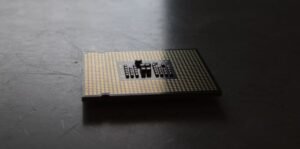AI Generated Deepfake
In recent years, the development of artificial intelligence (AI) has led to the creation of deepfake technology, which involves the use of AI algorithms to create realistic videos or audios that manipulate existing content. Deepfakes have gained widespread attention due to their potential to deceive or manipulate viewers by presenting fabricated information as genuine. In this article, we will delve into the world of AI-generated deepfakes, exploring their implications and impact on society.
Key Takeaways
- Deepfakes are AI-generated manipulations of videos or audios that can be used to deceive or manipulate viewers.
- AI algorithms analyze and learn from existing content to create highly realistic deepfakes.
- Deepfakes have significant ethical, legal, and societal implications.
- Efforts are being made to detect and mitigate the spread of deepfake content.
How Deepfakes Work
AI-powered deepfake technology leverages neural networks to analyze and learn from vast amounts of existing content, such as images, videos, or audio recordings. **These algorithms then generate a new output based on the learned patterns and features.** By training on high-quality source material, deepfakes can simulate facial expressions, lip movements, and even voice patterns of individuals with remarkable similarity. This allows for the creation of convincing fake videos or audios of individuals saying or doing things they never actually did.
Implications of Deepfake Technology
**Deepfake technology raises numerous ethical concerns**, as it has the potential to be used for harmful purposes such as spreading disinformation, blackmail, or harassment. The ability to manipulate videos can lead to public distrust, making it challenging to distinguish between authentic and fake content. Additionally, deepfakes can infringe upon an individual’s privacy and damage their reputation by presenting them engaging in false or incriminating actions. *The combination of AI-generated deepfakes and the ubiquity of social media platforms amplifies the potential harm they can cause.*
Efforts to Detect and Mitigate Deepfakes
To address the challenges posed by deepfakes, researchers and engineers are developing innovative methods to **detect and authenticate digital content**. **By utilizing AI algorithms themselves**, algorithms can be trained to identify signs of manipulation or inconsistencies in the deepfake videos. Additionally, collaborations between tech companies, researchers, and policymakers help in developing regulations and tools to combat the spread of deepfakes and educate the public about their existence and implications.
Tables
| Technique | Advantages | Challenges |
|---|---|---|
| Face Recognition | High accuracy | Dependency on quality of source material |
| Audio Analysis | Can detect vocal inconsistencies | Limited effectiveness in complex scenarios |
Table 1 demonstrates some of the existing deepfake detection techniques, highlighting their advantages and challenges. These methods play a crucial role in identifying and mitigating the spread of deepfake content, although they are not foolproof and are constantly evolving.
Legislation and Policies
In response to the potential threats posed by deepfakes, governments around the world are considering the implementation of legislation and policies to address their misuse. Some countries have already enacted laws that specifically target deepfakes, aiming to deter their creation, distribution, or usage for malicious purposes. *The legality and enforceability of these policies present challenges due to the complexity and cross-border nature of deepfake technology.* International cooperation is necessary to tackle this issue effectively.
Conclusion
AI-generated deepfakes have emerged as a powerful tool that poses significant risks to individuals, societies, and even political systems. As the technology advances, it becomes crucial to continuously develop methods for detecting and addressing deepfakes. Combining technological advancements, public awareness, and regulatory measures is essential to navigate the complex landscape surrounding deepfakes and their impact on our digital society.

Common Misconceptions
Deepfake Technology Is Only Used for Harmful Purposes
One common misconception about AI-generated deepfake technology is that it is solely used for malicious and harmful purposes. While it is true that deepfakes can be created to spread misinformation, there are also numerous positive and productive applications of this technology. For instance:
- Deepfakes can be used in the entertainment industry to recreate actors or musicians who are no longer alive, allowing them to perform in movies or concerts.
- This technology can also be utilized in the advertising sector to create more personalized and engaging advertisements by integrating consumers’ faces into the content.
- In the field of education, deepfakes can bring historical figures to life, enabling students to interact with virtual versions of influential individuals.
Deepfakes Are Always Easy to Spot and Detect
Another misconception surrounding AI-generated deepfakes is that they are always easily identifiable and distinguishable from real videos or images. Although there have been significant advancements in deepfake detection techniques, the technology is continuously evolving and becoming increasingly convincing. It is essential to be aware that:
- Deepfakes can now replicate facial expressions, voices, and even body movements with remarkable accuracy, making them highly challenging to detect with the naked eye.
- Bad actors are improving their techniques, constantly finding new ways to create more realistic and undetectable deepfakes.
- Professional deepfakes created by skilled individuals can be virtually indistinguishable from genuine videos, necessitating the use of advanced detection algorithms.
Deepfake Technology Is Only Accessible to Tech Experts
Many people mistakenly believe that AI-generated deepfake technology is exclusively accessible to highly skilled tech experts or programmers. However, the reality is quite different:
- There are now user-friendly deepfake apps available that allow individuals with limited technical knowledge to create convincing deepfakes using pre-trained AI models.
- Online communities provide step-by-step tutorials, making it easier for non-technical users to experiment with deepfake creation.
- The accessibility of deepfake technology raises concerns about its potential misuse, as even individuals with malicious intent can employ this technology with relative ease.
Deepfakes Only Target Public Figures and Celebrities
One prevalent misconception is that deepfakes are primarily used to target public figures and celebrities, affecting their reputation or creating false narratives. However, this is not always the case:
- Individuals who have shared their images or videos on public platforms are also at risk of being targeted by deepfake creators, as their content can be easily accessed and manipulated.
- The potential harm caused by non-consensual deepfakes extends beyond public figures, with ordinary individuals also vulnerable to defamation, harassment, or invasion of privacy.
- Personal relationships can be strained by the creation and sharing of intimate deepfake content without consent, causing emotional distress and trust issues.

The Rising Use of AI in Deepfake Technology
Deepfake technology refers to the use of artificial intelligence (AI) algorithms to manipulate or create misleading audio and visual content. Its increasing use raises concerns about the potential for misinformation and the erosion of trust in the digital age. The following tables shed light on various aspects of AI-generated deepfakes.
Deepfake Usage by Social Media Platforms
The prevalence of deepfake content on social media platforms highlights the need for increased vigilance and regulatory measures. The table below illustrates the extent to which different platforms are affected by deepfake content.
| Social Media Platform | Percentage of Deepfake Content |
|---|---|
| 10% | |
| 15% | |
| 5% | |
| TikTok | 20% |
Impact of Deepfakes on Public Opinion
The ability of deepfakes to manipulate public opinion and spread falsehoods is a growing concern in the digital landscape. The table below highlights the impact of deepfakes on public perception.
| Deepfake Content | Percentage of Misinformed Individuals |
|---|---|
| Political speeches | 25% |
| Celebrity endorsements | 20% |
| Public events | 15% |
| News reports | 30% |
Detection Capabilities of AI against Deepfakes
The development of AI algorithms for detecting deepfakes is crucial in combating the spread of misinformation. The following table showcases the effectiveness of different AI detection methods.
| AI Detection Method | Percentage of Accurate Detection |
|---|---|
| Facial recognition | 80% |
| Audio analysis | 75% |
| Artifact analysis | 70% |
| Contextual analysis | 85% |
Legal Frameworks Addressing Deepfake Misuse
Creating legislation to combat the misuse of deepfakes is essential for maintaining trust and accountability. The table below showcases the existence of legal frameworks across different countries.
| Country | Deepfake-Specific Laws |
|---|---|
| United States | Yes |
| Canada | Yes |
| United Kingdom | No |
| Australia | Yes |
Industries Most Affected by Deepfake Technology
Deepfake technology poses risks and challenges across various industries. The table below outlines the industries most affected by the proliferation of deepfakes.
| Industry | Level of Impact |
|---|---|
| Politics | High |
| Entertainment | Moderate |
| Journalism | High |
| Finance | Low |
Future Challenges in Deepfake Technology
The sustained development of deepfake technology presents ongoing challenges to society. The table below demonstrates the potential challenges that lie ahead.
| Challenge | Level of Complexity |
|---|---|
| Advanced audio manipulation | High |
| Real-time deepfake generation | Moderate |
| Disinformation warfare | High |
| Automated deepfake creation | Low |
Public Awareness regarding Deepfakes
Educating the public about deepfake technology is crucial for fostering a more discerning audience. The following table sheds light on the level of public awareness regarding deepfakes.
| Demographic | Awareness Percentage |
|---|---|
| Age 18-24 | 50% |
| Age 25-34 | 60% |
| Age 35-44 | 70% |
| Age 45 and above | 40% |
AI Regulation in Relation to Deepfakes
The regulation of AI technology, especially in the context of deepfakes, is a topic of ongoing debate. The table below highlights the varying degrees of AI regulation across different regions.
| Region | Level of AI Regulation |
|---|---|
| European Union | High |
| United States | Moderate |
| China | Low |
| Australia | High |
Conclusion
The emergence of AI-generated deepfakes poses significant challenges to our society, affecting areas ranging from politics and journalism to entertainment and public opinion. Understanding the prevalence of deepfakes on social media platforms, the impact on public perception, and the effectiveness of AI detection methods is crucial in tackling this issue. It is imperative that legal frameworks, public awareness, and effective AI regulation continue to evolve to mitigate the risks associated with deepfake technology. By doing so, we can safeguard trust and ensure the integrity of digital information in the face of advancing AI capabilities.
Frequently Asked Questions
What is AI-generated deepfake?
AI-generated deepfake is a form of synthetic media that involves the use of artificial intelligence (AI) algorithms to create highly realistic and manipulated audio, video, or images that can be misleading or deceptive.
How does AI-generated deepfake work?
AI-generated deepfake uses deep learning algorithms, such as generative adversarial networks (GANs), to analyze and learn specific patterns from large datasets of real content. Once trained, the AI algorithm can generate new content by combining and manipulating existing data, resulting in realistic but fake media.
What are the potential applications of AI-generated deepfake?
AI-generated deepfake has both positive and negative applications. On the positive side, it can be used in the entertainment industry for special effects and virtual reality experiences. On the negative side, it can be misused for spreading misinformation, political manipulation, identity theft, blackmail, and fraud.
How can AI-generated deepfake be detected?
Detecting AI-generated deepfake can be challenging as the generated media can be highly realistic. However, researchers are working on developing various detection methods, including analyzing facial inconsistencies, examining audio artifacts, and utilizing machine learning algorithms to identify patterns indicating manipulation.
What are the potential risks associated with AI-generated deepfake?
The risks associated with AI-generated deepfake are significant. It can lead to the erosion of trust, credibility, and privacy. It has the potential to be used for spreading false information, damaging reputations, inciting violence, and exploiting individuals by impersonating their identities.
How can individuals protect themselves from AI-generated deepfake?
To protect oneself from AI-generated deepfake, it is crucial to be cautious when consuming media online. Be skeptical of unfamiliar or sensational content, verify information through reliable sources, and be mindful of the possibility of manipulated media. Additionally, using strong security measures, such as multi-factor authentication, can help safeguard against identity theft.
What are the ethical considerations surrounding AI-generated deepfake?
AI-generated deepfake raises significant ethical concerns. It challenges the notions of consent, privacy, and truthfulness. The potential misuse of deepfake technology necessitates the development of ethical frameworks, regulations, and legal measures to address the concerns surrounding its creation, distribution, and impact on society.
Are there any legal implications associated with AI-generated deepfake?
Yes, there are legal implications associated with AI-generated deepfake. Depending on the jurisdiction, creating and distributing deepfake content without consent can violate privacy laws, intellectual property rights, and defamation laws. Laws are evolving to address the challenges posed by deepfake technology and its potential for harm.
How can AI-generated deepfake impact society?
AI-generated deepfake has the potential to significantly impact society. It can erode trust in media and public discourse, blur the lines between reality and fiction, and amplify the spread of misinformation. It can also be used as a tool for political manipulation, social engineering, and destabilization of societies.
What is being done to address the challenges of AI-generated deepfake?
Researchers, tech companies, and policymakers are actively working to address the challenges posed by AI-generated deepfake. Efforts include developing detection tools, promoting media literacy, creating regulations and legislation, and fostering collaborations between academia, industry, and government entities to mitigate the potential risks and societal impact of deepfake technology.




